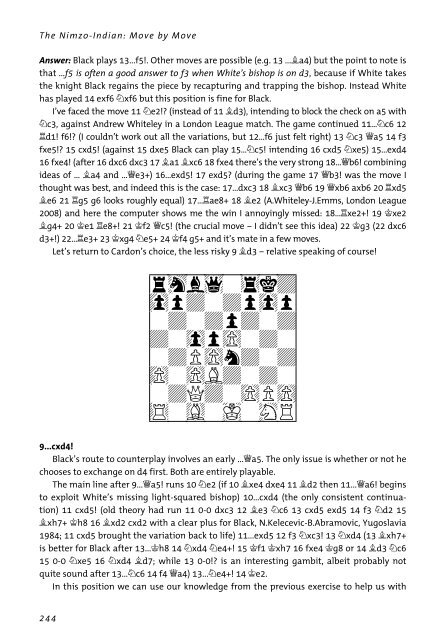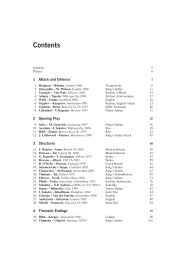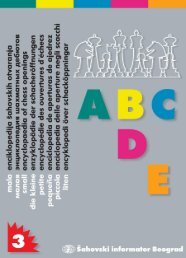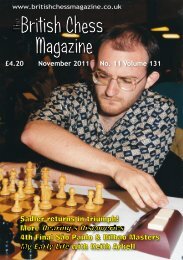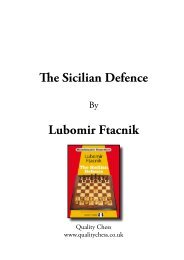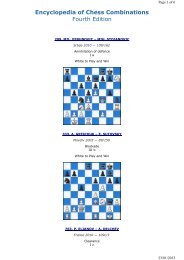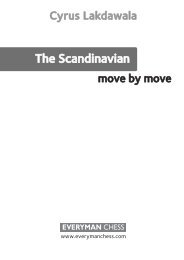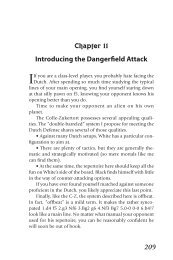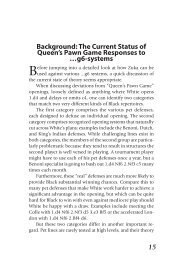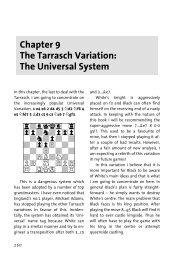View sample pages (pdf) - Chess Direct Ltd
View sample pages (pdf) - Chess Direct Ltd
View sample pages (pdf) - Chess Direct Ltd
You also want an ePaper? Increase the reach of your titles
YUMPU automatically turns print PDFs into web optimized ePapers that Google loves.
The Nimzo-Indian: Move by MoveAnswer: Black plays 13...f5!. Other moves are possible (e.g. 13 ...Ía4) but the point to note isthat ...f5 is often a good answer to f3 when White’s bishop is on d3, because if White takesthe knight Black regains the piece by recapturing and trapping the bishop. Instead Whitehas played 14 exf6 Ìxf6 but this position is fine for Black.I’ve faced the move 11 Ìe2!? (instead of 11 Íd3), intending to block the check on a5 withÌc3, against Andrew Whiteley in a London League match. The game continued 11...Ìc6 12Îd1! f6!? (I couldn’t work out all the variations, but 12...f6 just felt right) 13 Ìc3 Ëa5 14 f3fxe5!? 15 cxd5! (against 15 dxe5 Black can play 15...Ìc5! intending 16 cxd5 Ìxe5) 15...exd416 fxe4! (after 16 dxc6 dxc3 17 Ía1 Íxc6 18 fxe4 there’s the very strong 18...Ëb6! combiningideas of ... Ía4 and ...Ëe3+) 16...exd5! 17 exd5? (during the game 17 Ëb3! was the move Ithought was best, and indeed this is the case: 17...dxc3 18 Íxc3 Ëb6 19 Ëxb6 axb6 20 Îxd5Íe6 21 Îg5 g6 looks roughly equal) 17...Îae8+ 18 Íe2 (A.Whiteley-J.Emms, London League2008) and here the computer shows me the win I annoyingly missed: 18...Îxe2+! 19 Êxe2Íg4+ 20 Êe1 Îe8+! 21 Êf2 Ëc5! (the crucial move – I didn’t see this idea) 22 Êg3 (22 dxc6d3+!) 22...Îe3+ 23 Êxg4 Ìe5+ 24 Êf4 g5+ and it’s mate in a few moves.Let’s return to Cardon’s choice, the less risky 9 Íd3 – relative speaking of course!W________W[rhb1W4kD][0pDWDp0p][WDWDpDWD][DW0p)WDW][WDP)nDWD][)W)BDWDW][WDQDW)P)][$WGWIWHR]W--------W9...cxd4!Black’s route to counterplay involves an early ...Ëa5. The only issue is whether or not hechooses to exchange on d4 first. Both are entirely playable.The main line after 9...Ëa5! runs 10 Ìe2 (if 10 Íxe4 dxe4 11 Íd2 then 11...Ëa6! beginsto exploit White’s missing light-squared bishop) 10...cxd4 (the only consistent continuation)11 cxd5! (old theory had run 11 0-0 dxc3 12 Íe3 Ìc6 13 cxd5 exd5 14 f3 Ìd2 15Íxh7+ Êh8 16 Íxd2 cxd2 with a clear plus for Black, N.Kelecevic-B.Abramovic, Yugoslavia1984; 11 cxd5 brought the variation back to life) 11...exd5 12 f3 Ìxc3! 13 Ìxd4 (13 Íxh7+is better for Black after 13...Êh8 14 Ìxd4 Ìe4+! 15 Êf1 Êxh7 16 fxe4 Êg8 or 14 Íd3 Ìc615 0-0 Ìxe5 16 Ìxd4 Íd7; while 13 0-0!? is an interesting gambit, albeit probably notquite sound after 13...Ìc6 14 f4 Ëa4) 13...Ìe4+! 14 Êe2.In this position we can use our knowledge from the previous exercise to help us with244


